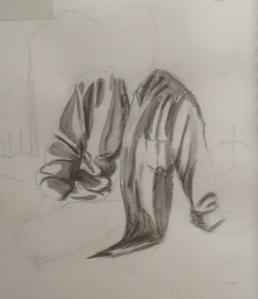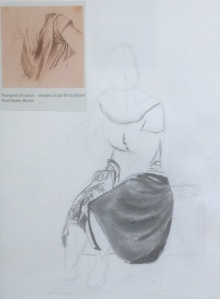Objective
- Sketch a seated figure wearing a plain and pale coloured shawl, baggy jumper or soft dressing gown.
- Using very light marks, sketch the overall shape of the seated figure, remembering to fit it interestingly within the borders of the support. Concentrate on drawing the body and the fabric as though it were a single form, considering the cloth as much a part of the body as the skin, flesh and bones.
- Lightly and simply indicate the general shapes for the head, hands and feet without going into detail.
Preparation

Paula Rego
Pastel on paper laid on aluminium,
NPG 6351
Before starting this exercise I viewed pieces of work that had previously caught my interest and imagination. Germaine Greer 1995 by Paula Rego (Fig 1) really captured my imagination when it was exhibited at the National Portrait Gallery London. I’m still not sure what grabbed me about this piece; the composition, colours or fact that Greer was wearing her favourite Jean Muir dress and old gold shoes, yet her hands are rough from gardening. Perhaps it was all of the aforementioned. The course material for this exercise makes reference to creating the illusion of three-dimensional form and believable weight. I felt that Rego’s piece does this exceptionally well; through her shoulders to her elbows and onto her knees as her legs are pushed apart, supported only by the soles of her shoes butted against one another.
Process
I started this exercise by sketching the outline of the model using a 2B pencil (Fig 2). I applied an ink wash to pick out the mid tones, and once dry, a Charcoal pencil for the dark tones. The light tones were left white. For this first attempt I wanted to create the illusion of three-dimensional form and weight of the model as she rested and leans to her left (right as you look). I think the oversized shirt obscures this somewhat. As a result felt that while the left side of the drawing was successful, the right was not.

Having rearranged the position of the model I repeated this exercise except this time I used a blue ink wash (Fig 3) to define tonal values. Once it had dried I didn’t feel the oversized shirt was suitable for the exercise and therefore took it no further.

Despite knowing what I wanted to achieve I wasn’t sure how to achieve it. In essence I struggling to define the shape of the body against the cloth. After some internet research I came across The Spirit of Justice, a drapery study by Ford Madox Brown (Fig 3 – top left). The depiction of tonal values is a marvel, even letting the colour of paper come through to enhance the lightest tonal areas. For my next attempt (Fig 4) my model is wearing a black glossy, three-quarter length dress. Using a charcoal stick I sketched the outline of the model. I then used the side of the stick to depict the dark tones. With only the dark tones on the page I sprayed it with a pastel fixative. Once the pastel fixative was dry (it only takes a couple of minutes) I went over the dark tones again. I then used my fingers to pull the charcoal from the dark tones into the mid-tones. Finally, I used a putty rubber to lift the lighter tones.

I repeated the above for my next piece (Fig 5), except this time I used dark grey heavyweight cartridge paper. My inspiration came from Study of Drapery 1508 by Albrecht Dürer.

To develop this further I repeated this exercise using the same mediums on A2 fine grain heavyweight paper (Fig 6). The heavyweight paper has sufficient tooth to allow the charcoal to bite, but with equal qualities to allow the whiteness of the paper to come through to depict light and mid tones.

Reflection
The first thing to reflect upon is the patience of a life drawing model. If anyone thinks it’s easy – give it a go.
As for this exercise, the intent was to consider how the fabric helps invoke the essence of a living being beneath the surface. To achieve this I found that I needed to use variation of tone and directional marks to depict the shape of the material and figure as one. Clothing that gives the figure shape and definition certainly helps, unlike Fig 1 and 2 where the model was wearing an oversized shirt. I have predominantly used charcoal and soft pastel for this exercise but I a sure there will be opportunities to experiment with other mediums during this part of the course in order to develop this practice.